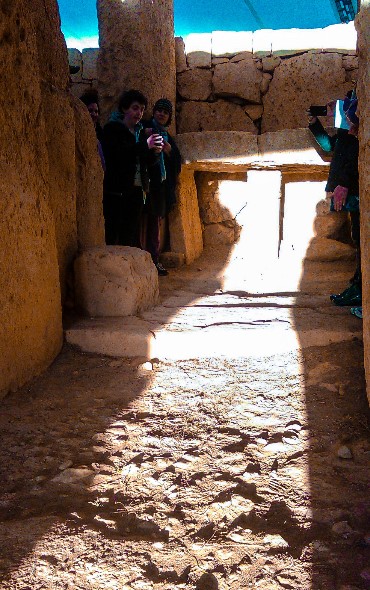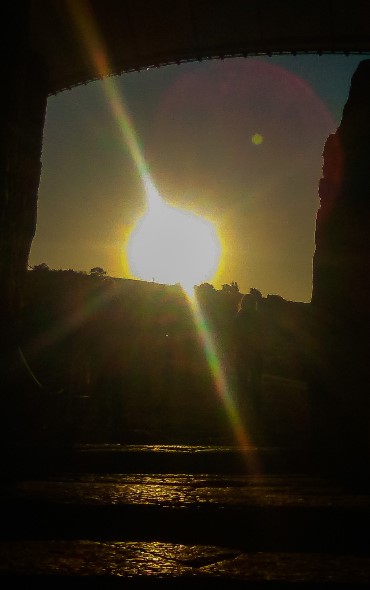Here’s why the Equinox at Hagar Qim and Mnajdra Temples in Malta is one of the most extraordinary archaeoastronomical events on the planet!

Melanie Drury
As the first rays of sunlight appear over the horizon on the day of the Equinox, the central corridor of the South Temple at Mnajdra slowly becomes flooded with golden light, shining through to the innermost apse. A group of people (curious archeologists, devout pagans and everything in between), who have been waiting in anticipation since before dawn to witness the extraordinary phenomenon, are instantly rewarded. The temple is suddenly shrouded in light, and energy is buzzing within its standing stone walls as everyone stands in wonder. The Equinox at Mnajdra is perhaps just one of those things that is understated when described and must be experienced - just like chocolate.
The mysterious Megalithic Temples of Malta
The extraordinary Megalithic Temples of Malta remain shrouded in mystery, and all we can do is throw in a few educated guesses. Yet, while little is actually known, there is a lot to be said about the temples.
I could offer you a historians’ account of the prehistoric builders’ way of life from what they have managed to piece of the puzzle. I could point out the remarkable density of sites on the islands – there are a staggering over 50 sites within a mere 320 km² – and their curious positioning on ley lines and why this might be. Or, I could tell you about the mystical perspective offered by Francis Xavier Aloisio in his books, where he ties the temples to a past relating to Atlantis, and beings from out of this world.
But some things need no guesswork. The evidence is right there before your eyes, and no-one can deny it. One of these things is the incredible astronomical orientation of the Hagar Qim and Mnajdra Temples, which are, effectively, a timeless calendar that has been marking the change of the seasons - the equinoxes and the solstices - for over 5,000 years.
Could an early farming civilisation really have planned such complex temples and this extraordinary phenomena merely to mark the time for planting and harvesting crops?
What happens at Hagar Qim and Mnajdra Temples during the equinoxes and solstices?

Melanie Drury
Sunrise on the day of a solstice or equinox is when the relationship between Hagar Qim and Mnajdra Temples and the seasons becomes evident. The orientations of the temples are so systematic that it is highly probable that they were intentional at the time of building - quite a feat for a bunch of prehistoric farmers, in my humble opinion!
The phenomena at Hagar Qim and Mnajdra Temples occur precisely during the Vernal Equinox (20th-21st March), the Summer Solstice (21st June), the Autumnal Equinox (21st-22nd September) and the Winter Solstice (21st December).
Equinoxes and solstices have marked the change of seasons since time immemorial. A solstice is when the sun is at its northernmost or southernmost position as viewed from Earth, experienced as the shortest and longest days. An equinox is when the sun “crosses” the Earth’s equator, causing equal hours of light and dark. It is truly remarkable how effectively Hagar Qim and Mnajdra Temples highlight these moments in time.
Mnajdra Temples
Mnajdra, a complex of three temples that demonstrate advanced building knowledge and engineering and an extremely high level of workmanship, is perhaps the most remarkable, as it is effectively a year-round calendar. During the equinox, the sun rises in perfect alignment with the main doorway, flooding the central corridor to the innermost apse with sunlight. The solstices, on the other hand, are marked by the narrowest of beams of light, just making it through the main doorway and shining onto the furthest edge of a slab on the apse at sunrise, the last point before it starts to edge its way back to the centre in time for the next equinox.
Hagar Qim Temples
Hagar Qim is significant for the large number of important artefacts recovered from the site, including human figures, now on display in the National Museum of Archaeology in Valletta. It is also known for its “oracle hole”, a curious elliptical hole located on one side that allows light from the sunrise to enter an apse of the temple, aligning on the 21st June, the summer solstice. However, more importantly, the Hagar Qim temples demonstrate an observation of stellar bodies spanning 18 years.
A wonderful mystery that can never be unravelled
That the Hagar Qim and Mnajdra Temples together form an accurate solar and lunar calendar is an awesome fact, but the how, why and by who will always remain a mystery. To think that the islands’ inhabitants more than 5,000 years ago had such understanding of the cosmos and the ability to construct such a precise feat of engineering is truly baffling.
Experience it for yourself
Each year, Heritage Malta organises tours of the Hagar Qim and Mnajdra Temples at dawn, to witness these spectacular events. Booking in advance is essential, as numbers are restricted.
Experience to believe!